You're using an outdated browser. Please upgrade to a modern browser for the best experience.
Please note this is a comparison between Version 2 by Catherine Yang and Version 1 by Roberto GIACOMOBONO.
Grid converters play a central role in renewable energy conversion. Current source inverter (CSI) can play a pivotal role in ensuring the seamless conversion of solar-generated energy with the electricity grid, thereby facilitating stable and reliable integration of solar photovoltaic systems.
- current source inverter
- photovoltaic
- power conversion
- solar photovoltaic systems
1. Introduction
In recent years, photovoltaic (PV) systems have gained significant attention as a renewable energy solution, contributing to the global efforts towards sustainable development and combating climate change. Central to the efficient functioning of these systems are inverters, which play a crucial role in converting the direct current (DC) generated by solar panels into alternating current (AC) that can be used to power electrical devices and feed energy back into the grid [1,2][1][2]. The rapid growth of PV systems as a clean and sustainable energy solution has sparked immense interest in improving the components of these systems, due to its main properties:
-
Inherent short-circuit protection;
-
Low current and voltage harmonics.
One of the topologies that has gained an increasing importance in the field of PV systems is the current source inverter (CSI). CSIs offer several advantages over other inverter technologies, making them a popular choice for both residential and utility-scale PV installations. Interconnected systems are categorized according to the quantity of power processing stages, utilization of transformers, transformerless configurations, and the type of commutation. Consequently, topologies relying on the number of stages in energy processing are classified into single- and multistage systems, as illustrated in Figure 1.
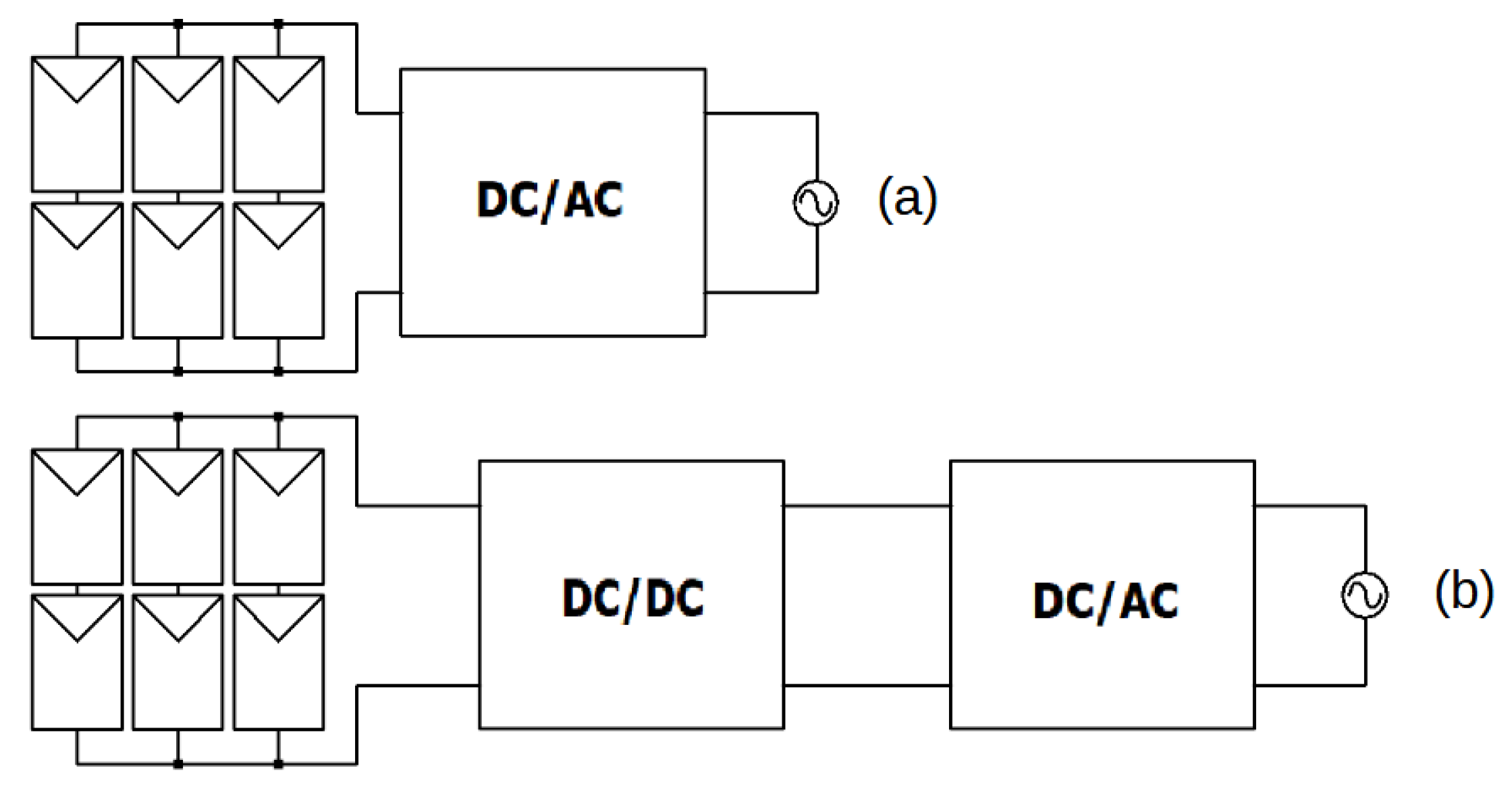
Figure 1.
Types of PV inverters: (
a
) single stage, (
b
) multi stage.
The single-stage CSI is a straightforward and cost-effective solution, suitable for small-scale PV installations. It offers higher efficiency but may require additional filtering to address voltage harmonics. On the other hand, multi-stage CSI allows for more flexibility and control over the output waveform, making it a preferred choice for larger PV systems where power quality is crucial. However, it involves more complex circuitry and has a slightly lower overall efficiency due to additional conversion stages. The choice between single-stage and multi-stage CSI depends on the specific requirements and priorities of the PV system application.
2. Performance of CSIs in Photovoltaic Systems
Inverter performance is critical in determining the overall efficiency and effectiveness of PV systems. Among various inverter technologies, CSIs have emerged as a reliable solution for converting DC power from solar panels into AC power suitable for grid connection. This article aims to comprehensively examine the performance of CSIs in photovoltaic systems, highlighting important parameters such as conversion efficiency, stability, energy quality, power factor, dynamic response, and variation management of solar radiation.| System | Reliability |
|---|
-
Interface with PV modules: Effective interface between CSIs and PV modules is crucial for optimized power conversion and energy extraction. Challenges may arise from module-level variations, partial shading conditions, or differences in maximum power points. Advanced techniques such as distributed maximum power point tracking (DMPPT) [65][25], module-level power electronics, and innovative bypass diode configurations can address these challenges. These solutions enable CSIs to efficiently interface with PV modules and extract maximum energy, ensuring optimal system performance;
| VSI | 93.78% |
| CSI (three-leg) | 96.48% |
| CSI (four-leg) | 98.04% |
- ]
- [
- ]
- and a non-SiC diode in series, as well as legs equipped with SiC MOSFETs and a SiC Schottky diode in series
- [
3. Control of CSIs in Photovoltaic Systems
The control strategies employed in CSIs in PV systems focus more on techniques such as MPPT control, predictive control strategies, and more (Figure 25).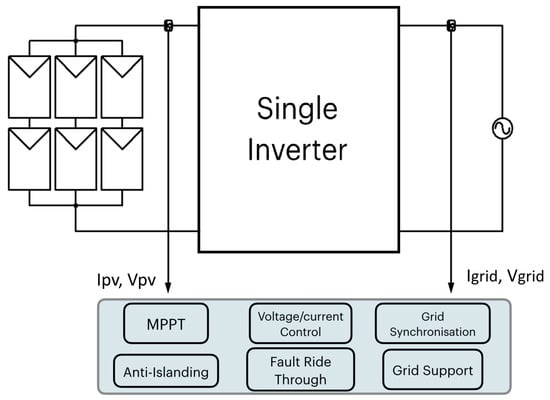
Figure 25.
Block diagram single inverter.
-
Current sensing and monitoring: Implementing precise current sensing and monitoring techniques is crucial in CSIs. Real-time current measurements can detect open circuit faults promptly. When an open circuit fault is detected, the inverter can respond by reducing its output voltage, limiting the risk of overvoltage conditions;
-
Active voltage control: Advanced control algorithms can be employed to actively manage the output voltage of CSIs. By modulating the switching patterns of the inverter in response to system conditions, the voltage output can be controlled within safe limits, even in the presence of open circuit faults;
-
Feedback mechanisms incorporate feedback mechanisms that continuously assess the output voltage and current. These feedback loops can adjust the operation of the inverter to ensure that the voltage remains within predefined boundaries, reducing the risk of overvoltage;In Figure 26 M is the modulation index, and the current control loop operates significantly faster than the voltage control loop;
-
Fault detection algorithms develop fault detection algorithms specifically designed for CSIs. These algorithms can quickly identify open circuit faults and trigger protective actions to prevent overvoltage. They can also distinguish between genuine faults and transient conditions.
- ]
- . The research findings indicate that the parasitic capacitance of the series diode significantly impacts the switching performance, limiting the achievable switching frequencies.
- Reliability and durability: The performance of CSIs is also influenced by their reliability and durability. These inverters are designed with robust components, thermal management systems, and advanced protection mechanisms to withstand various environmental conditions, such as temperature variations and humidity. Reliability features, including fault detection and protection against voltage spikes metal-oxide-semiconductor varistors (MOVs) or current surges
- [
- ][11], contribute to the long-term performance and durability of CSIs in photovoltaic systems. A reliability study of CSI and Voltage Source Inverter (VSI) systems connected to a transformerless power grid [19][12] concludes that the CSI topology is the most reliable. Furthermore, among the CSI topologies, the four-leg one has a reliability greater than 98% (Table 102).
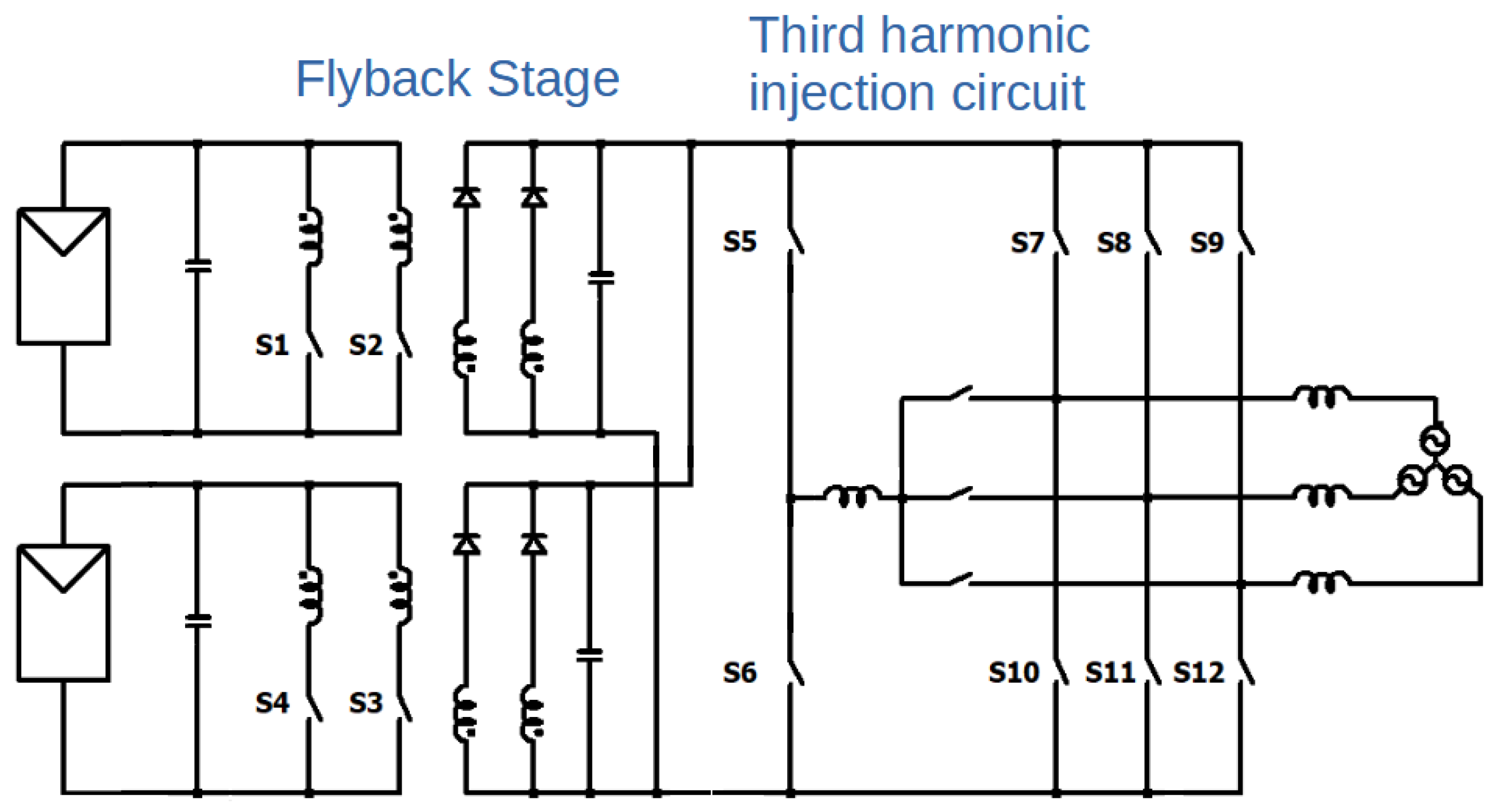
Figure 22.
Reactive power control of grid-connected photovoltaic microinverter based on third-harmonic injection.

Figure 23.
Control PLL based on third-harmonic injection.
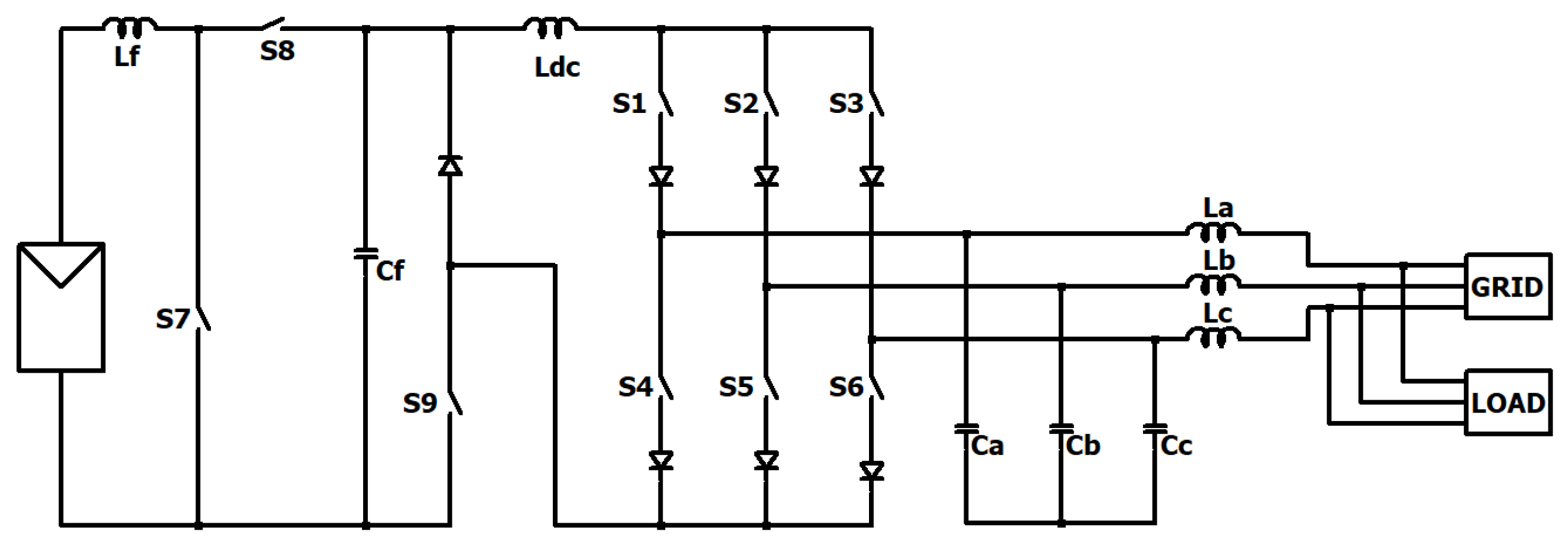
Figure 24.
Three-phase current source shunt active power filter with solar photovoltaic grid interface.
Table 91.
Potential solutions for harmonics reduction in CSIs.
| Solution Category | Description |
|---|---|
| Multilevel topologies | Implement multilevel CSI topologies (e.g., three-level, five-level) that inherently generate cleaner output voltage with reduced harmonics |

Figure 26.
Dual-loop control system: current and voltage.
Table 113.
Potential solutions for control mechanism optimization in CSIs.
| Solution Category |
|---|
-
MPPT control is a key control technique used in CSIs to optimize the PV array output power. MPPT algorithms continuously monitor operating conditions and dynamically adjust the operating point to extract maximum power from the solar arrays. Various MPPT algorithms, such as Perturb and Observe (P&O), Incremental Conductance (IC), and Fractional Open Circuit Voltage (FOCV), are commonly employed in CSIs to ensure efficient energy conversion, as in Figure 2
| Description |
|---|
- 7.
| Advanced control algorithms | Implement advanced control algorithms that optimize the current waveform, enhance tracking of maximum power points, and improve overall system efficiency |
- Predictive control strategies offer advanced control capabilities for CSIs in PV systems. Model Predictive Control (MPC) and Direct Predictive Control (DPC) are examples of predictive control techniques used to optimize the performance of CSIs. These strategies use mathematical models of the system and predictive algorithms to make control decisions in real time, ensuring optimal power extraction, rapid response to changing conditions and improved stability. Using MPPT control data, the three state vectors for an SVM modulation in a three-phase CSI can be calculated [46][16]. In [15][17], an artificial neural network-based fuzzy logic controller (FLC) [59][18
| Passive filters | |||
| Utilize passive filters (e.g., LC filters) to mitigate harmonics by attenuating unwanted frequency components in the output | |||
| Adaptive control strategies | Utilize adaptive control strategies that can dynamically adjust control parameters based on changing operating conditions, maximizing performance | Active filters | Employ active filters (e.g., active power filters) to actively suppress harmonics by injecting counteracting currents into the system. |
| Model predictive control | Apply model predictive control (MPC) techniques for real-time optimization of system parameters and accurate prediction of future states | Soft switching | Implement soft-switching techniques, such as resonant converters, to reduce switching-related harmonics and minimize high-frequency noise |
| Digital signal processing | Incorporate digital signal processing (DSP) for precise control and harmonic compensation, enabling fine-grained control of output waveforms | Improved component design | Optimize the design of power electronic components (e.g., inductors, capacitors) to minimize harmonic generation and enhance filtering effectiveness |
| Predictive control methods | Employ predictive control methods to anticipate system behavior and optimize control actions accordingly, minimizing response time | Advanced PWM techniques | Apply advanced pulse-width modulation (PWM) techniques (e.g., space vector PWM) for precise control of switching patterns, reducing harmonics |
| Grid-side solutions | Employ grid-side solutions, including grid-tied filters and STATCOMs, to improve power quality and reduce harmonics at the point of grid connection |
- ]
- , coupled with a nonlinear sliding mode control (SMC) for power grid connection demonstrates the capability to achieve lower THD compared to the SMC approach.
| System modeling | |
| Sensor-less control | |
| Develop accurate system models for predictive control and harmonics analysis, enabling proactive harmonic mitigation strategies | |
| Improved control algorithms | Implement advanced control algorithms that optimize the current waveform and minimize harmonic distortion in the output |
| Implement sensor-less control techniques that reduce hardware complexity by relying on advanced algorithms for feedback and system monitoring | |
| Adaptive modulation schemes | |
| Employ adaptive modulation schemes that can dynamically adjust modulation indices and techniques to match varying load conditions | |
| Synchronization algorithms | Utilize synchronization algorithms for accurate grid interconnection, ensuring seamless integration with the electrical grid |
| Real-time monitoring | Integrate real-time monitoring and diagnostics to continuously assess system performance and make adjustments for optimization. |
| Harmonic compensation | Develop strategies for harmonic compensation to counteract harmonic distortions and enhance the quality of the output voltage |
- Integration with energy storage systems: The integration of Energy Storage Systems (ESSs) with PV systems is gaining traction to enable efficient energy management and grid support. CSIs can be tailored to facilitate seamless integration with ESSs. Challenges in ESS integration include bidirectional power flow, battery management, and control coordination. Advanced control algorithms, bidirectional power converters, and communication protocols enable CSIs to effectively interface with ESSs, allowing for optimized energy utilization, peak shaving, and grid ancillary services;
-
Monitoring and control systems: Reliable monitoring and control systems are essential for efficient operation, performance evaluation, and fault detection in PV systems with CSIs. Challenges involve real-time data acquisition, system diagnostics, and remote control capabilities. Advanced monitoring and control solutions, such as supervisory control and data acquisition (SCADA) systems, IoT-based technologies, and predictive maintenance algorithms, offer comprehensive monitoring, precise control, and effective system management. These solutions enhance the performance and reliability of PV systems with CSIs;
-
Efficiency is a critical performance metric for CSIs, as it directly impacts the energy conversion process. CSIs are known for their high conversion efficiencies, resulting in minimal power losses during the DC to AC conversion. Factors contributing to their efficiency include advanced control algorithms, optimized switching techniques, and low conduction and switching losses. High-efficiency CSIs ensure maximum power generation from the PV system, thereby maximizing the overall system performance and energy yield;
-
Stability is a critical performance parameter for CSIs, ensuring their reliable and consistent operation. By maintaining stable voltage and frequency levels, CSIs contribute to a robust and secure grid integration. Advanced control strategies, including grid synchronization techniques and voltage regulation algorithms, enable CSIs to adapt to varying operating conditions and maintain stability even under fluctuating solar irradiance levels. Dynamic modeling and stability analysis of a three-phase PWM-based CSI for standalone applications, based on an analytical and experimental investigation, verify that the examined topology can effectively operate as a boost converter with a VLLrms/Vdc ratio exceeding 3, while ensuring a THD below 5% [49][3]. This characteristic is particularly advantageous for applications utilizing low voltage DC links;
-
Power quality: Maintaining high-power quality is essential for PV systems to ensure reliable and stable operation. CSIs excel in this aspect by offering superior power quality features. Their precise current control capability allows for low harmonic distortion and reactive power compensation, ensuring compliance with grid standards and reducing the risk of grid disturbances. One of the techniques for reactive power control of the grid-connected photovoltaic microinverter is based on third-harmonic injection [7][4] to achieve better overall power quality (Figure 22).The circuit is controlled by a phase-locked loop (PLL)-based controller as shown in Figure 23.Additionally, CSIs exhibit an excellent dynamic response, enabling seamless load adaptation and grid synchronization. A particular single stage solar inverter using a unique active filter that replicates the behavior of a conventional second order LC mains filter was presented in [50
- ]
- [
- ]. This solution (Figure 24) offers the flexibility to adjust the cutoff frequency, allowing emulation of the desired reactance for efficient filtering. Additionally, the proposed system incorporates active closed-loop filtration to continuously monitor and improve power quality. An active power filter for grid connection that uses a shunt active power filter that can be used even when the PV array is not sending energy to the grid was proposed in [51][6]. The control is used simultaneously by MPPT and harmonic compensation.The compensation of the harmonics introduced by the network takes place through the introduction of a reactive power q and the two passive elements, Ldc and Cdc, can be controlled via a switching strategy to act as an active LC filter. To improve the control of the active power shunt filter connected to a photovoltaic system is to directly control the power by selecting the combination of switches to be applied based on a switch [52][7]. The potential solutions for reducing harmonics in current source inverters are summarized in Table 91.These potential solutions address the challenge of reducing harmonics in CSIs and improving the quality of the output voltage. The choice of solution(s) to implement will depend on specific system requirements, performance objectives, and constraints in the photovoltaic or other applications using CSIs;
-
Power factor: Maintaining a high power factor is crucial for efficient power transmission and utilization. CSIs offer excellent power factor control, ensuring a near unity power factor during grid connection. By actively managing the power factor, CSIs improve system efficiency and minimize losses, enhancing the overall performance of the PV system;
-
Dynamic response of CSIs refers to their ability to quickly and accurately respond to load changes and variations in solar irradiance levels. CSIs exhibit excellent dynamic response characteristics, allowing them to adapt to rapid changes in load demand and maintain stable grid integration. Their fast response time and advanced control algorithms enable smooth transitions and reliable operation under dynamic conditions;
-
Management of solar irradiance variations: CSIs are designed to handle variations in solar irradiance levels effectively. Through advanced MPPT algorithms, they optimize the power output from solar panels, maximizing energy harvest even under varying solar conditions. This effective management of solar irradiance variations ensures optimal performance and energy production throughout the day;
-
Grid integration: The seamless integration of PV systems with the electrical grid is a key performance requirement. CSIs facilitate smooth grid integration through their ability to regulate voltage and frequency, support reactive power control, and provide anti-islanding protection. By actively interacting with the grid, CSIs ensure stable and reliable operation, minimizing the risk of grid instability or disruptions. This feature is particularly important in utility-scale PV systems where grid compliance and grid support functionalities are essential. An article presents and examines a prototype of a Silicon Carbide (SiC) current source inverter CSI that analyzes the switching performance of legs constructed with SiC MOSFETs [53,54][8
Table 102.
Reliability of CSI and VSI systems.
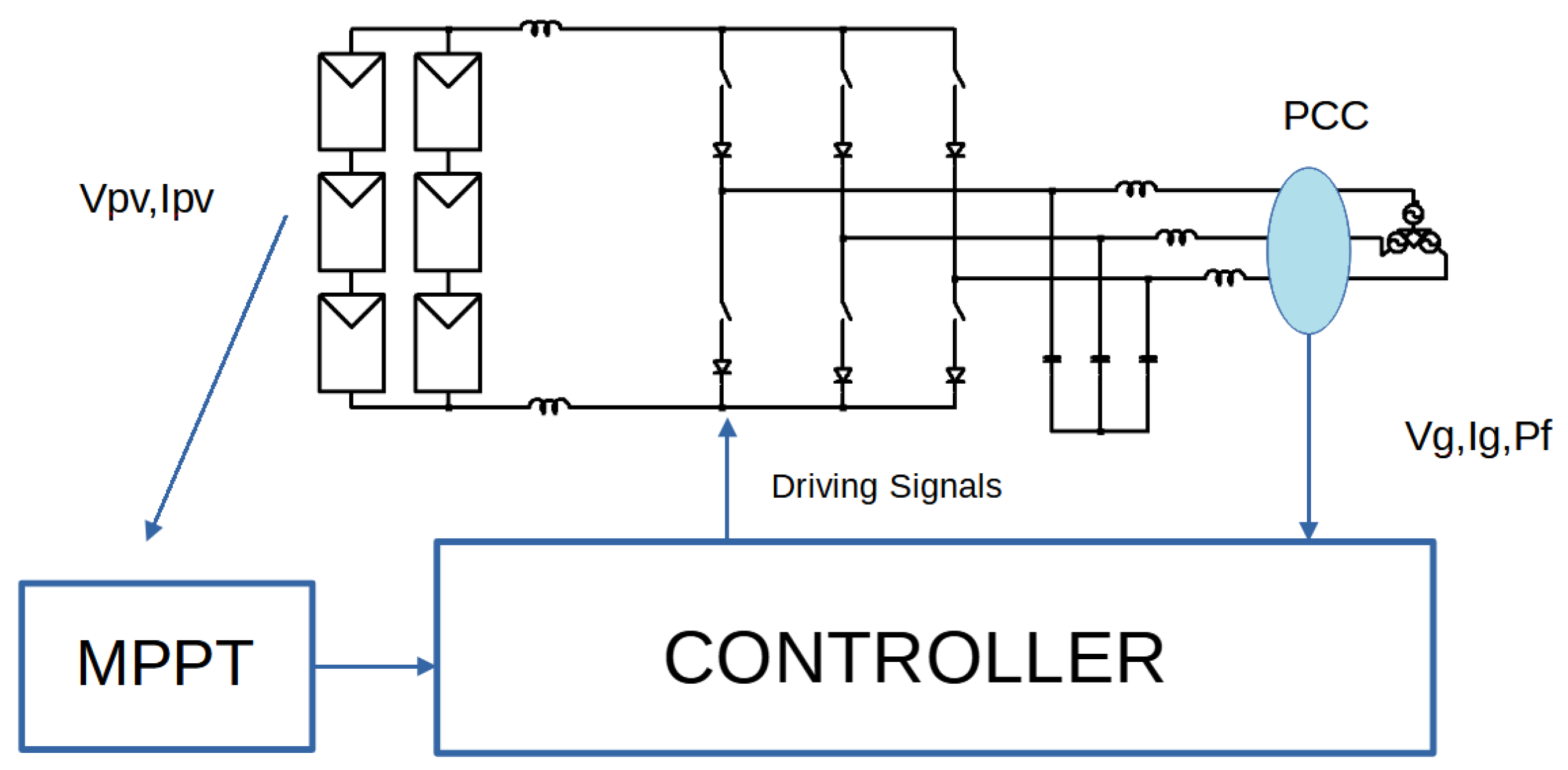
Figure 27.
Control system of MPPT with single inverter.

Figure 28.
Block diagram of the FLC-based MPPT.
4. Integration of CSIs in Photovoltaic Systems
Integrating CSIs into photovoltaic systems presents challenges and strategies for interfacing with PV modules, energy storage systems, monitoring and control mechanisms, and more. The most relevant ones are:- Regulatory and grid connection requirements: Integrating CSIs into PV systems requires compliance with regulatory and grid connection standards. These standards may include grid codes, safety regulations, and certification requirements. Challenges arise in meeting grid compliance, anti-islanding protection, and grid support functionalities. CSIs should incorporate protection mechanisms, voltage and frequency control algorithms, and communication protocols to ensure compliance with regulatory and grid connection requirements. Adhering to these standards ensures safe and reliable operation while supporting the stability and integrity of the electrical grid.
References
- Kolantla, D.; Mikkili, S.; Pendem, S.R.; Desai, A.A. Critical review on various inverter topologies for PV system architectures. IET Renew. Power Gener. 2020, 14, 3418–3438.
- Kouro, S.; Leon, J.I.; Vinnikov, D.; Franquelo, L.G. Grid-connected photovoltaic systems: An overview of recent research and emerging PV converter technology. IEEE Ind. Electron. Mag. 2015, 9, 47–61.
- Singh, A.; Kaviani, A.K.; Mirafzal, B. On dynamic models and stability analysis of three-phase phasor PWM-based CSI for stand-alone applications. IEEE Trans. Ind. Electron. 2015, 62, 2698–2707.
- Noori, F.T.; Hassan, T.K. Reactive power control of grid-connected photovoltaic micro-inverter based on third-harmonic injection. Int. J. Power Electron. Drive Syst. IJPEDS 2021, 12, 2169.
- Mariappan, B.; Fernandes, B.G.; Ramamoorty, M. A novel single-stage solar inverter using hybrid active filter with power quality improvement. In Proceedings of the IECON 2014—40th Annual Conference of the IEEE Industrial Electronics Society, Dallas, TX, USA, 29 October–1 November 2014.
- Exposto, B.; Monteiro, V.; Pinto, J.G.; Pedrosa, D.; Melendez, A.A.N.; Afonso, J.L. Three-phase current-source shunt active power filter with solar photovoltaic grid interface. In Proceedings of the 2015 IEEE International Conference on Industrial Technology ICIT, Seville, Spain, 17–19 March 2015.
- Krama, A.; Zellouma, L.; Rabhi, B. Improved control of shunt active power filter connected to a photovoltaic system using technique of direct power control. In Proceedings of the 2016 8th International Conference on Modelling, Identification and Control, Algiers, Algeria, 15–17 November 2016.
- Catellani, S.; Bier, A.; Martin, J.; Alves-Rodrigues, L.G.; Barruel, F. Characterization of 1.2kV silicon carbide SiC semiconductors in hard switching mode for three-phase current source inverter csi prototyping in solar applications. In Proceedings of the PCIM Europe 2015; International Exhibition and Conference for Power Electronics, Intelligent Motion, Renewable Energy and Energy Management, Nuremberg, Germany, 19–20 May 2015; pp. 155–162.
- Yang, X.; Zhao, Z.; Wang, C.; Xu, J.; Liu, K.; Qiu, J. Analysis and parameter design of SiC-based current source inverter (CSI). World Electr. Veh. J. 2022, 13, 187.
- Martin, J.; Bier, A.; Catellani, S.; Alves-Rodrigues, L.G.; Barruel, F. A high efficiency 5.3kW current source inverter CSI prototype using 1.2kV silicon carbide SiC bi-directional voltage switches in hard switching. In Proceedings of the PCIM Europe 2016, Nuremberg, Germany, 10–12 May 2016; pp. 1–8.
- Rubino, L.; Rubino, G.; Marino, P.; Di Noia, L.P.; Rizzo, R. Universal circuit breaker for pv power plants. In Proceedings of the 2017 6th International Conference on Clean Electrical Power (ICCEP), Santa Margherita Ligure, Italy, 27–29 June 2017; pp. 750–755.
- Potdukhe, K.C.; Munshi, A.P.; Munshi, A.A. Reliability prediction of new improved current source inverter CSI topology for transformer-less grid connected solar system. In Proceedings of the 2015 IEEE Power, Communication and Information Technology Conference PCITC, Bhubaneswar, India, 15–17 October 2015.
- Prasad, M.; Akella, A.K. Comparative analysis of PV fed VSI, CSI and ZSI based UPQC for mitigation of voltage sags and harmonics. Int. J. Renew. Energy Res. 2017, 7, 668–675.
- Satapathy, L.M.; Kumar, N.; Dehury, S.; Pradhan, B.; Saif, M. Performance analysis of three-phase inverter in solar PV system under dynamic load condition. In Proceedings of the 2018 Second International Conference on Intelligent Computing and Control Systems ICICCS, Madurai, India, 14–15 June 2018.
- Yenan Chen, D.M.X. Review of soft-switching topologies for single-phase photovoltaic inverters. IEEE Trans. Power Electron. 2021, 37, 1926–1944.
- Exposto, B.; Rodrigues, R.; Pinto, J.G.; Monteiro, V.; Pedrosa, D.; Afonso, J.L. Predictive control of a current-source inverter for solar photovoltaic grid interface. In Proceedings of the 2015 9th International Conference on Compatibility and Power Electronics CPE, Costa da Caparica, Portugal, 24–26 June 2015.
- Nabgha, A.S.M.; Ouassaid, M. Fuzzy logic and sliding mode control for a grid-connected current source inverter photovoltaic system. In Proceedings of the 2018 6th International Renewable and Sustainable Energy Conference IRSEC, Rabat, Morocco, 5–8 December 2018.
- Mosalam, H.A.; Amer, R.A.; Morsy, G. Fuzzy logic control for a grid-connected PV array through Z-source-inverter using maximum constant boost control method. Ain Shams Eng. J. 2018, 9, 2931–2941.
- Alajmi, B.N.; Ahmed, K.H.; Adam, G.P.; Williams, B.W. Single-phase single-stage transformer less grid-connected PV system. IEEE Trans. Power Electron. 2013, 28, 2664–2676.
- Soumana, R.A.; Saulo, M.J.; Muriithi, C.M. Comparison of MPPT techniques on THD current in a grid-connected photovoltaic system. In Proceedings of the 2022 4th Global Power, Energy and Communication Conference GPECOM, Nevsehir, Turkey, 14–17 June 2022.
- Wang, Z.; Miao, Z.; Fan, L.; Yazdani, A. Weak grid operation of a grid-following current-sourced PV solar system. In Proceedings of the 2021 North American Power Symposium NAPS, College Station, TX, USA, 14–16 November 2021.
- Kazerani, M.; Zhang, Z.C.; Ooi, B.T. Linearly controllable boost voltages from tri-level PWM current-source inverter. IEEE Trans. Ind. Electron. 1995, 42, 72–77.
- Komurcugil, H. Nonlinear control strategy for single-phase PWM current-source inverters. In Proceedings of the 2009 35th Annual Conference of IEEE Industrial Electronics, Porto, Portugal, 3–5 November 2009.
- Jayalath, S.; Hanif, M. Controller tuning for a single phase grid-connected current source inverter. In Proceedings of the 2015 IEEE 2nd International Future Energy Electronics Conference IFEEC, Taipei, Taiwan, 1–4 November 2015.
- Capasso, C.; Rubino, G.; Rubino, L.; Veneri, O. Power architectures for the integration of photovoltaic generation systems in DC-microgrids. Energy Procedia 2019, 159, 34–41.
More
